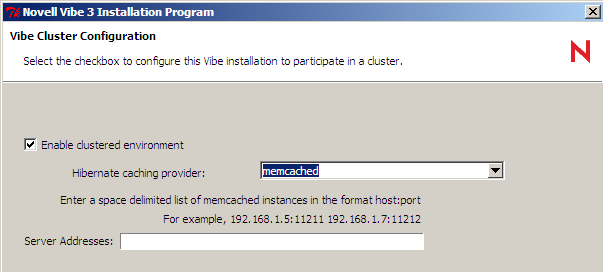15.2 Installing the Vibe Software on Multiple Servers
-
Update your existing Novell Vibe server to participate in a multi-server configuration:
-
Stop Vibe.
-
Start the Vibe Installation program.
For information on how to start the installation program, see Section 4.1.2, Running the Linux Vibe Installation Program or Section 4.2.2, Running the Windows Vibe Installation Program.
-
On the Installation Settings page, select , then click .
-
On the Choose Installation Type page, select , then click .
-
Click to proceed through the installation pages where no changes are needed.
-
(Conditional) If you do not have the Basic Vibe Installation Summary Sheet and Advanced Vibe Installation Summary Sheet from the initial Vibe server installation, record the configuration of the initial Vibe server as you proceed through the installation pages.
Subsequent Vibe servers in the multi-server configuration must be installed with the same configuration settings as the initial Vibe server.
-
On the Vibe Cluster Configuration page, select to enable clustering.
-
On the first Vibe node, in the field, specify worker1. On the second Vibe node, in the field, specify worker2, and so forth for each Vibe node, incrementing the JVM Route setting. Each tomcat instance should have a unique JVM Route setting.
worker1, worker2, and so forth are the default names for the matching values used for the reverse proxy configuration. For example, if you have set up Apache or IIS as a reverse proxy, these are the default values. The setting in the Vibe installer must match these values.
-
Select one of the following options for your hibernate caching provider:
ecache: Ecache is recommended for small clustered Vibe sites, and is included in the Vibe software. If you select this option, no further configuration is necessary. For more information, see Ehcache.
memcached: Memcached is recommended for medium to large clustered Vibe sites. Memcached is not included in the Vibe software. If you select this option, you must download and install memcached on each server in your Vibe cluster. For information about downloading and installing memcached, see Memcached.
Depending on the cache provider you select, different options are displayed.


-
(Conditional) If you selected as the hibernate caching provider in Step 1.g, specify the following information on the Vibe Cluster Configuration page to configure ehcache:
Network interface for distributed cache service: Specify the IP address or hostname of the distributed cache service.
Multicast Group Address: (Optional) Specify the common multicast group IP address. Each clustered node recognizes other nodes in the cluster by means of this IP address.
IMPORTANT:Make sure you specify the same IP address on all Vibe nodes in the cluster. After you have set this IP address for each Vibe node, restart each node in succession, allowing each node to initialize before restarting the next.
The default multicast group IP address is 232.0.0.1. If you have more than one clustered Vibe system (for example, one in the lab and one in production), or if you have another software product that is already using the default multicast group IP address, you must update this field for one system so that it uses an IP address other than the default.
Use an IP address in the range of 224.0.0.1 to 239.255.255.255.
Multicast Group Port: (Optional) Specify the port number through which the Vibe nodes will communicate.
-
(Conditional) If you selected as the hibernate caching provider in Step 1.g, specify the following information on the Vibe Cluster Configuration page to configure memcached:
Server Addresses: Specify a list of memcached servers, with each server separated by a space. For example, hostname1:port hostname2:port hostname3:port
Memcached is not included in the Vibe software. If you select memcached as your hibernate caching provider, you must download and install memcached on each server in your Vibe cluster. For information about downloading and installing memcached, see Memcached.
-
On the Ready to Install page, click .
-
On the Installation Complete page, click .
-
-
Install the Vibe software on each additional server, using the same installation settings that you used for the initial Vibe server.
-
On each Linux server where you installed the Vibe software, set the multicast route to enable the servers to function as a cluster:
-
Use the following command on the command line to immediately set the multicast route for the server:
route add -net 232.0.0.0/8 dev eth0
-
To run this command each time the server reboots, add the command to the following file on each server:
/etc/init.d/boot.local
-
-
Start Vibe on each server, as described for the platform where you are installing Vibe:
-
(Conditional) If you set up ehcache as the caching provider and the Vibe servers fail to start because of a communication error, ensure that you have followed the steps in Section 15.1.3, Configuring Routing for Multicast IP on the Vibe Server.
-
Continue with Configuring a Web Application to Provide High Availability Functionality for Your Vibe Site.